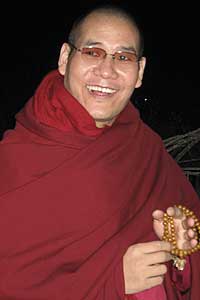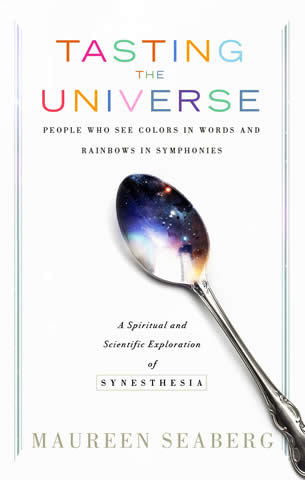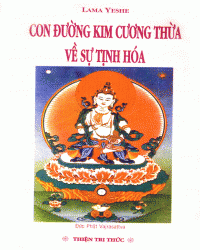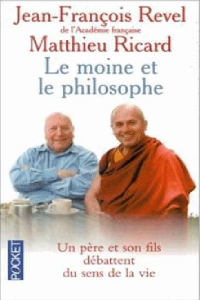Một Lạt Ma Tây Tạng Dùng Thiền Chữa Lành Bệnh Hoại Cơ
Một vị lạt ma Tây Tạng tin rằng ông chữa lành bệnh hoại cơ ở chân bằng thiền định qua một năm. Nhiều nhà khoa học hiện nay đang nghiên cứu não bộ của ông, hy vọng sẽ khám phá sự kỳ diệu y khoa.
Có thể nào năng lực của tâm giúp con người tự chữa trị? Đó là điều mà một nhóm khoa học gia hy vọng sẽ giúp quyết định qua việc nghiên cứu một vị lạt ma Tây Tạng tin rằng ông đã tự chữa lành bệnh hoại cơ bằng thiền định.
Khi Lạt Ma Tây Tạng Phakyab Rinpoche định cư tại Hoa Kỳ vào năm 2003, ông là một người tị nạn 37 tuổi với bệnh tiểu đường và *Bệnh Pott. Bệnh của ông đã trở nên trầm trọng làm bàn chân và chân phải phát triển chứng hoại cơ. Ông đã vào bệnh viện và khám nghiệm bởi 3 bác sĩ khác nhau tại thành phố

Phakyab Rinpoche (Đọc là: “Puk Yub Rin Poh Chey”)
Vài người sẽ chống lại lời khuyên y khoa như vậy, nhưng lạt ma Rinpoche không phải là người bình thường. Sinh vào năm 1966 tại tỉnh Kham, Tây Tạng, ông xuất gia năm 13 tuổi và được xác nhận là vị tái sanh thứ 8 của Phakyab Rinpoche bởi chính đức Đạt Lai Lạt Ma khi ông đang tiến vào cấp bậc cao nhất của ngành nghiên cứu Phật Giáo Tây Tạng, bằng Geshe [tiến sĩ Phật Học], vào năm 1993. Một vị tăng có đời sống tâm linh sâu xa đã hiến dâng đời mình cho Phật Pháp, một cách tự nhiên ông đã gặp vị đạo sư của mình là đức Đạt Lai Lạt Ma, khi quyết định cắt bỏ chân hay không.
Câu trả lời của đức Đạt Lai Lạt Ma gây sửng sốt: đừng cưa chân. Lạt Ma Rinpoche nói rằng vị lãnh đạo tinh thần Tây Tạng khuyên sử dụng trí tuệ của ông với pháp **thiền Tsa Lung - để tự điều trị, và rồi dạy người khác giá trị của truyền thống cổ xưa đó.
Đó là một quyết định đòi hỏi một bước nhảy toàn diện của niềm tin. Nhưng Rinpoche nói rằng không có gì nghi ngờ đối với ông. Dù các bác sĩ nói rõ là ông có thể chết, ông không sợ hãi. Ông nói với báo The Daily Beast qua thông dịch rằng, "Là một Phật tử, điều gì tệ hại nhất có thể xảy ra nếu tôi chết? Tôi sẽ tái sanh lại. Nhưng để mất một chân trong một lần thọ sanh bởi vì tôi không nỗ lực cứu chữa là điều không ý nghĩa chút nào."
Và như thế ông bắt đầu thiền định. Rinpoche nói rằng ông không uống thuốc và chế độ ăn kiêng của ngài là của một người bình thường.
Rồi, sau 9 tháng, ông nói rằng điều gì đó bắt đầu xảy ra mà nhiều người Mỹ xem như là một sự kỳ diệu. Nước chảy ra từ chân bị bệnh bắt đầu trong. Chỗ sưng xẹp xuống. Ngay sau đó ông có thể đặt một số đồ nặng lên đó. Vào đúng 10 tháng, ông có thể đi lại, đầu tiên với đôi nạng chống. Một thời gian ngắn sau đó ông đi bằng một chiếc nạng, và rồi, trước một năm, ông đi bộ mà không cần chống nạng nữa.
Hiện nay, một nhóm bác sĩ tại Đại Học
Tháng này, bác sĩ Bushell và nhà thần kinh tại Đại Học New York tiến sĩ Zoran Josipovic với sự hợp tác của Lạt Ma Rinpoche để thực hiện việc chiếu rọi qua máy MRI não bộ của ông trong khi lạt ma vào thiền định bên trong máy scanner tại Trung Tâm Chụp Hình Não Bộ của Đại Học New York.
Bác sĩ Bushell viết trong một phân tích khoa học sau khi chụp hình não bộ của Lạt Ma Rinphoche rằng, "Hòan toàn không rõ ràng từ quan điểm khoa học Tây phương gió là gì, nhưng chứng cứ khoa học cho tôi và những người khác thấy rằng tiến trình thiền định vận dụng gió đã làm tăng lưu lượng máu, hoạt động thể chất, và khí oxy." Ông nói tiếp rằng, "Hơn 10 năm nghiên cứu những ảnh hưởng của thiền định lên não bộ đã đạt được sự chú tâm của công chúng và khoa học không ngờ."
(Bài tạm dịch từ:) Maureen Seaberg
Tổng hợp (Yahoo news và theo: http://www.illuminations.org/Programs.html)
PHỤ-CHÚ
(1).gif)
Máy chụp cộng hưởng từ (MRI)
* Lao cột sống (Bệnh Pott) là bệnh không thường gặp ở các nước phát triển. Về phương diện hình ảnh học, việc chẩn đoán các tổn thương này có thể không cần phải cân nhắc hoặc có thể nhầm lẫn với bệnh viêm xương tủy nhiễm trùng sinh mủ.
Những đặc điểm mạnh mẽ nhất hướng đến chẩn đoán lao cột sống là tổn thương đĩa đệm tối thiểu, abscess lớn cạnh sống, bắt quang dạng viền dày xung quanh khối abscess trong thân sống và cạnh sống, lắng đọng vôi trong khối tụ dịch cạnh sống và phá hủy xương dạng mảnh rời. (Theo BV Hoàng Mỹ - Xem tại: http://hoanmysaigon.com/index.php?option=com_content&task=view&id=4906&Itemid=28)
** Thực hiện xong những pháp tu Bổn tôn của giai đoạn phát triển, hành giả sẽ thực hành các pháp tu về kinh mạch và những bài tập thân thể (Tsa-lung - tiếng Tây Tạng; Hathat-yoga - tiếng Ấn) với những thủ ấn của Bổn tôn (thực hành Tsa-lung, Skr: Prana, Nada, Bindu) qua 6 pháp Du-già bí truyền đặc biệt, gồm: 1. Nội hỏa (Tumo) - pháp gốc rễ; 2. Huyễn thân (Gyulu); 3. Quang minh (Odsel); 4. Chuyển mộng (Milam); 5. Vượt trung ấm (Bardo); 6. Chuyển thần thức (Phowa) (Xem tại: http://phatgiaovnn.com/upload1/bz/showthread.php?p=2291 )
BẢN TIN THAM KHẢO
Can Meditation Cure Disease?
Maureen Seaberg – Sat Dec 25, 7:15 pm ET
Can the power of the mind help humans self-heal? That’s what a group of scientists are hoping to help determine by studying a Tibetan lama who believes he cured himself of gangrene through meditation.
When Tibetan Lama Phakyab Rinpoche immigrated to the
Few people would go against such medical advice, but Rinpoche (pronounced Rin-Poh-Chey) is no average person. Born in 1966 in
The Dalai Lama’s response was shocking: Do not amputate. Instead, Lama Rinpoche says, the Tibetan spiritual leader advised his protégé to utilize his virtuoso skills at Tsa Lung meditation—heal himself, and then teach others the value of the ancient tradition. He sent a letter prescribing additional mantras, such as the Hayagriva, which, at the outset of new endeavors, is said to clear obstacles and provide protection in their tradition.
It was a decision that would require an incomprehensible leap of faith. But Rinpoche says there was no doubt within him. Though doctors had made it clear he could die, he was not afraid. “As a Buddhist, what is the worst thing that could happen if I die?” he told The Daily Beast through a translator. “I would be reborn again. But to lose a leg in one lifetime because I didn’t try to save it didn’t make sense.”
And so he began to meditate. Rinpoche says he took no medicine and his diet was an ordinary one. He would break for meals—when the lama he was living with came home from work, they would have dinner and enjoy conversation—but then he would return to meditating before getting a good night’s sleep at the end of the day. In the morning, he would awake and return to his routine.
In the early days of this ritual, Lama Rinpoche remembers, the putrid ooze from his leg ran black; a few months later it turned cloudy, he said, and bruising started to appear. The swelling increased and it was more painful. The odor was sickening, he recalls. But still he felt no doubt.
The progression of the degradation wasn’t simply halted—his leg was back from the dead.
Then, after nine months, he says something began to happen that many Americans would consider a miracle. The liquid leaking from his disabled leg began to run clear. The swelling went down. Soon he could put some weight on it. At ten months, he could walk again, first with crutches. A short time later he was down to one crutch, and then, before even a year had passed, he was walking on his own.
The progression of the degradation wasn’t simply halted—his leg was back from the dead. His diabetes and complicating Tuberculosis are gone today as well.
Now, a group of doctors at
"This is a cognitive-behavioral practice that present East-West science suggests may be more effective that any existing strictly Western medical intervention,” says Dr. William C. Bushell, an MIT-affiliated researcher in medical anthropology and director of East-West Research for Tibet House in New York. Gangrene is not curable by current medical intervention once past a certain point in its progression, except by amputation.
This month, Dr. Bushell and NYU neuroscientist Zoran Josipovic, Ph.D. won Lama Rinpoche’s cooperation in undergoing a functional MRI scan of his brain while he meditated inside the scanner at NYU’s Center for Brain Imaging. In this first scan the Rinpoche participated in an ongoing study of the effects of different types of meditations on anti-correlated networks in the brain that Dr. Josipovic has been conducting at NYU.
Bushell wrote a scientific analysis of the processes occurring in the same form of meditation used by Rinpoche in a letter to Joshua Lederberg, Nobel Prize winner in medicine, some 10 years ago. Dr. Lederberg was one of the giants of modern science, father of molecular biology, infectious disease medicine, and modern genetics. His foundation published the letter, which is actually an adaptation of a scientific paper, posthumously on his website. It speaks of the mild to moderate hyperthermia resulting from the practice, which kills bacteria and aids the body in healing.
“It is not entirely clear from a Western science perspective what the winds are, but the scientific evidence suggests to me and others that the meditative process involving winds includes increased local blood flow, metabolic activity, and oxygenation,’’ Bushell explains. “The original scientific model I developed (which is largely in a theoretical state) was based on, among other things, the pioneering work of Thomas K Hunt, MD, on the antibiotic properties of oxygenation in the blood and surrounding tissues, and was sponsored by the Institute of Noetic Sciences in Petaluma, Calif. Research shows that mental imagery directed to sites of the body, both superficial as well as deeper tissues, can with practice eventually lead to increased local blood flow, metabolic activity, and oxygenation. Such increases could in principle combat even powerful bacteria such as Staphylococcus aureus, which not only can be the cause of gangrene, but is now often times resistant to antibiotics.”
Dr. Bushell’s colleague Dr. Josipovic was also very curious about Rinpoche’s abilities and, in particular, about the way they may have affected the functional and structural organization of his brain. The early results of the test are significant at first glance, he says. They show changes in a wide network of brain areas mediating attention and awareness. The team will publish their findings next year.
“Over the past 10 years research into the effects of meditation on the brain has been gaining unprecedented public and scientific attention,” Dr. Josipovic explains. “What these studies have shown is that it is possible to optimize ones life experience through cultivation of subtle cognitive states generated through meditation, and that these are accompanied by changes in the anatomical structure of the brain, or neuroplasticity. But what soon became evident was that a great variety of meditation techniques and states of consciousness they engender, pose a considerable challenge for understanding them in terms of the established constructs of Western science.”
Dr. Josipovic says that a major new discovery in the field of neuroscience, that of spontaneously fluctuating resting-state networks in the brain, has the potential to shed some light on this issue. “On a global level, the brain appears to be organized into two large-scale networks: extrinsic, or the task-positive network, composed of the brain areas that are active when we are focused on some task or external environment, and the intrinsic, or ‘default’ network, composed of the areas that are active when we reflect on ourselves and own experience.”
These networks are usually anti-correlated in their activity—that is, when one is “up” the other is “down,” he says. “While this antagonism serves some healthy functions, for example, of allowing us to focus on a task and refrain from being distracted by daydreaming or irrelevant concerns, we suspect it may also underlie some unhealthy aspects of our everyday experience, such as excessive fragmentation between self/other and internal/external—in other words the ‘dualistic mind’ that many contemplative traditions see as the root of our suffering.’’
Those who wish to begin a Tsa Lung practice, which is an advanced but achievable discipline, are encouraged to seek a teacher. Rinpoche himself teaches often across the country, and is adding a website www.awakeningmindfoundation.org and Skype to his teaching sessions to reach more people around the world. This year he will lead a special New Year gathering in
MaryAnn Zitka, a medical researcher and senior student of Phakyab Rinpoche explains that the word Rinpoche is a Tibetan Buddhist honorific title that literally means the precious one. “This is a very appropriate title to me,” she says. “It’s not often that you meet someone so committed to helping others. Rinpoche freely teaches his wisdom traditions to all who wish to learn, and his only request is to practice.”
Maureen Seaberg is a NYC-based journalist whose work has appeared in the New York Times, the Daily News, Irish
THEO Yahoo news
CHÚ-THÍCH:
*synesthete: from the ancient Greek σύν (syn), "together," and αἴσθησις (aisthēsis), "sensation,"is a neurologically-based condition in which stimulation of one sensory or cognitive pathway leads to automatic, involuntary experiences in a second sensory or cognitive pathway. People who report such experiences are known as synesthetes.
(THEO: http://en.wikipedia.org/wiki/Synesthesia)

Trích1Hơn năm trăm năm trước Tây lịch vào đêm trăng tròn đầu tiên của tháng Vesakha theo lịch Ấn Độ, Ngài Siddhartha Gautama ngồi xếp bằng theo thế kiết già dưới gốc
Các bạn thân mến, Nếu có một dịp được chứng kiến cảnh các vị sư Tây Tạng thực hiện đồ hình Mạn-đà-la (Anh: mandala, Phạn: maṇḍala, Tây Tạng: dkyil 'khor, Hoa: 曼荼羅) thì
Thông qua quyền lực của sự kiềm chế, chúng ta có thể bắt đầu tiến trình của việc tháo gỡ suy nghĩ và phóng chiếu của tâm từ hiện thực về điều
Luật Nhân Quả Trong Đời Sống Xã Hội và Khoa HọcLUẬT NHÂN QUẢ LÀ MỘT CUỘC CÁCH MẠNG TÂM LINHKhi con người không hiểu luật nhân quả, con người sống trong sự
VIDYADHARA MIGYUR DORJE Trích từ Terma của Vidydhara Terton Migyur Dorje (1645-1667) ẤN-TỐNG Điện thoại liên hệ : Thị Đức: 0908-273 213 , Mr Lộc : 0903 - 824 440 nhận Kinh. Trang
QUAN HỆ THẦY TRÒ Theo Tinh thần Kinh Kế thừa Chánh pháp Thầy, vầng mây bậc, thong dong, núi cao biển rộng Con, cánh nhạn chiều, chân trời sải cánh, dõi theo Thầy,
Giữ giới là lựa chọn tự do Giới luật của Phật giáo có nghĩa là: “Anh đừng tự làm thương tổn mình, anh đừng tự làm hại mình”. 1. Tự do của lệ thuộc
Đạo Phật là gì Lama Zopa and Lama Yeshe Khi bạn tìm hiểu về đạo Phật tức là bạn đang tìm hiểu về con người thật của mình, về bản chất của tâm trí
Vô minh bẩm sinh & Vô minh văn hóa(VHPG) Mọi kinh nghiệm của chúng ta, kể cả giấc mộng, khởi lên từ vô minh. Đây là một tuyên bố làm hoảng hốt

